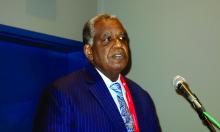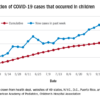The socioeconomic revolving door of 30-day heart failure readmissions
Patients receiving even top-notch hospital care for heart failure (HF) are, once discharged to home, at higher short-term risk of another HF hospitalization if home is in a socioeconomically deprived neighborhood. That helps explain why Blacks in the United States have a much higher 30-day HF readmission risk than Whites, a disparity that only worsens with the level of neighborhood deprivation, a new analysis suggests.
Some systemic and entrenched socioeconomic inequities that health care providers have little sway over, and which disproportionately affect Black individuals, are independent and robust predictors of worsened HF outcomes, Alanna A. Morris, MD, MSc, Emory University, Atlanta, said during her presentation at the virtual annual scientific meeting of the Heart Failure Society of America.
In a retrospective cohort study, Blacks had a 45% higher risk of 30-day readmission than Whites (P < .001) independent of cardiovascular risk factors, clinical history, comorbidities, type and location of hospital, and type of third-party payer coverage. The analysis included more than 30,000 patients with at least one HF hospitalization at centers in a major metropolitan health system.
The racial disparity widened with worsening socioeconomic deprivation of patients’ residential neighborhoods, that is, with rising quartiles of neighborhood scores on the Social Deprivation Index (SDI).
The SDI, based on U.S. census data, incorporates seven socioeconomic criteria, including household income, education level, employment, and prevalence of rented housing and households that are without a car, single parent, or overcrowded.
There was a 4–percentage point gap in adjusted 30-day readmission rate between Blacks and Whites in the lowest quartile that widened to more than 8 points by the third quartile; the disparity in both the second and fourth quartiles was the same, at about 5.5 percentage points.
A remaining question, Dr. Morris said in an interview, is why the outcomes disparity between Blacks and Whites peaks in the third SDI quartile but drops a bit in the fourth quartile representing the most severe neighborhood deprivation.
“Our hypothesis is that when you look at patients who are the poorest, who live in the most deprived neighborhoods, race may be less of a factor,” she said. Socioeconomic deprivation may have similar consequences for everyone “regardless of race, ethnicity, gender, or other demographic characteristics if you live in a neighborhood that’s highly deprived.”
Based on the current study, “it does appear that increased heart failure incident rates are related to living in deprived neighborhoods, and it raises important clinical and public health concerns that must be addressed,” Keith C. Ferdinand, MD, Tulane University, New Orleans, said as invited discussant after the presentation from Dr. Morris.
“These findings could serve as an aid to policy makers, going forward, in terms of allocating resources for primary health care,” he said. “And it’s important looking at these data and other [data] that we target heart failure patients who reside in deprived neighborhoods before, during, and [after] hospitalization.”
Dr. Morris agreed that policy makers are in a better position to attack the racial disparity in HF readmission rates identified in the study. “This is not a problem that can be fixed within the health care system.”
If the reported interpretation is correct, it could add a twist to the public health care debate in the United States, observed session moderator Mandeep R. Mehra, MD, Brigham and Woman’s Hospital in Boston.
That debate, he noted, has often focused on insurability, access to coverage, and the merits or shortcomings of a single-payer system. Yet the study suggests outcomes disparities stemming from neighborhood deprivation will not be corrected by improved access to health insurance, a conclusion he finds “startling,” Dr. Mehra said in an interview.
Some proposed explanations for the disparities by race blame unequal access to health care and or variable health insurance coverage, Dr. Morris observed in an interview. But “that may not fully explain the increased risk that we see.”
Black patients followed at Emory University’s advanced HF clinic still have a higher risk of rehospitalization than Whites. “These are patients who have insurance, who are followed by advanced heart failure providers, who are on equal amounts of guideline-recommended medical therapy – and you still see about a 50% higher risk of rehospitalization,” Dr. Morris said, citing data that isn’t part of the current analysis.
“We can say that these patients are certainly able to access care, because they are able to access our emergency room and be taken care of within the hospital setting,” he said. The study controlled for whether health coverage was by private insurance, Medicare, or Medicaid.
Instead, the current analysis points to socioeconomic and environmental factors as a major source of the disparity in 30-day readmissions, Dr. Morris said.
“When patients are discharged from our healthcare systems, they still go back into environments where they don’t have the same resources as patients who live in higher-SDI neighborhoods,” she explained.
For example, “we tell them to eat low-sodium [foods], exercise, eat fresh fruits and vegetables, take their medicines, but the reality is that certain neighborhoods within the United States – and this is much more true for Blacks – make it very difficult to follow those self-care recommendations.”
The analysis included 16,147 Black patients and 14,483 White patients hospitalized with HF within the Emory Healthcare system at least once from 2010-2018, Dr. Morris reported. Compared with Whites, Blacks were younger (63.5 vs 69.1 years) and less likely to be 65 or older (48.9% vs. 66.5%); more likely to be women (53.5% vs. 42.2%), more likely to reside in deprived census tracts and to have diabetes, hypertension, or chronic kidney disease
In all, 20.6% of Black and 13.5% of White patients were readmitted for HF within 30 days of discharge, for an unadjusted risk ratio of 1.52 (95% CI, 1.44-1.61). The RR hardly budged, 1.45 (95% CI, 1.37-1.54, P < .001), after adjustment for age, sex, type of insurance, type of HF, vital signs and laboratory values, medical history (diabetes, hypertension, atrial fibrillation, coronary disease, chronic kidney disease, and chronic pulmonary disease), Charlson Comorbidity Index, discharging medical specialty, and hospital location. The excess in 30-day HF readmissions for Black, compared with White patients climbed from the first to the third neighborhood SDI quartile, the disparity peaking at 8.2 absolute percentage points. A major criticism of the Hospital Readmissions Reduction Program component of the Affordable Care Act, Dr. Morris said in a Q&A discussion after her presentation, is that it can hold hospitals “responsible for structural inequalities that exist beyond the health care system,” including neighborhood deprivation. “But public policy makers have to realize that there are certain patients we take care of who don’t have the resources to carry out the therapeutic lifestyle changes that will allow them to live healthy.” The HRRP’s 30-day HF readmission metric that steers reimbursement “is penalizing health care systems across the United States” with its premise that hospital performance can be measured by 30-day HF readmission rates, Dr. Morris said in an interview. “The reality is that some of these patients are going to a postdischarge environment that is inherently high risk, and that many of them are going to come back to us within 30 days,” she said. “We would like to make sure that we don’t put excess penalties on health care systems that take care of disproportionate numbers of African Americans in neighborhoods that have fewer resources.” Dr. Morris and Dr. Ferdinand have disclosed no relevant financial relationships. Dr. Mehra discloses consulting or serving on an advisory board for Abbott, Medtronic, Janssen, Leviticus, NupulseCV, FineHeart, Portola, Bayer, the Baim Institute for Clinical Research, and Mesoblast. A version of this article originally appeared on Medscape.com.







